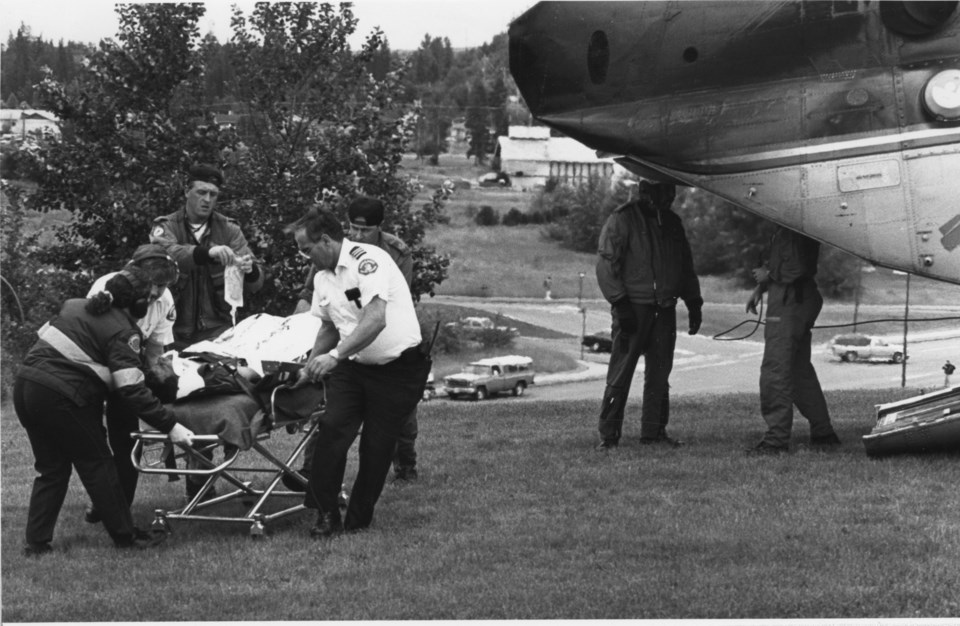Retired family physician Vernon Johnson remembers that decades ago, helicopters used to rush critically-injured patients directly to Prince George hospital.
But Prince George Regional Health Authority (PGRHA), in consultation with Transport Canada, deemed the helipad unsafe in the late 1990s, deciding the potential danger to area residents in the event of a helicopter crash was not considered worth the risk.
That helipad area is now covered by the emergency department parking lot, and Johnson, who retired in 1996 after 33 years at PGRH, claims that because direct helicopter hospital transfers no longer exist for northern B.C. residents, victims of serious trauma and critically ill patients are losing the battle against time.
"When I was in practice, that [helicopter emergency medical service] was a very important detail in the emergency ward, especially if we had a traffic accident on the highway or if there was an accident at one of the sawmills," said Johnson.
"They would land next to the highway and bring somebody in. The fact they're not doing that now seems incredible to me."
When Johnson arrived in Prince George in 1963, like the rest of the medical doctors on staff at Prince George Regional Hospital (PGRH), each month he'd take on call shift to accompany helicopter crews on rescue missions.
Doctors were prepared to fly out from the hospital helipad and rush patients back for further treatment.
He suggests the roof of the existing emergency ward could be reinforced to allow for helicopter landings, with a dedicated elevator installed to allow for patient access.
"This is a hospital that serves the whole northern half of the province," he said. "We need the best facilities possible."
Pacific Western Helicopters on Cowart Road now has the closest base to UHNBC, about a six-minute ambulance ride from the hospital.
"Now it happens very sporadically," said Pacific Western Helicopters president Ray Curry. "But back when there was a lot going on in the logging industry we would have more frequent medevacs. As the economy slowed down and as people aren't in the bush, obviously the requirement's not there."
Curry said it takes on average about a half-hour to connect BCAS paramedics with a flight crew and launch a helicopter mission.
RISK NOT WORTH IT: NORTHERN HEALTH
The most recent hospital helicopter landing took place in 1993, when a military chopper brought highway accident victims to the St. Giles Presbyterian Church parking lot along 15th Avenue.
"We looked at this in the late '90s as we were doing the redevelopment of the hospital and the restrictions on helipads in residential areas are significant," said Northern Health Authority chief operating officer Michael McMillan.
"We met with Transport Canada a couple times and didn't feel we could actually meet the requirements in terms of helicopters. The flight path was extremely challenging at this site, particularly to bring in single-engine helicopters [which fall rapidly in the event of engine failure]. It was felt we couldn't get a certified site on this property and that the actual advantage was small, compared to both the cost and difficulty."
The faded paint that marked the ground-level helipad was covered over with concrete when PGRH (now known as University Hospital of Northern B.C.) expanded 12 years ago in a $54 million renewal project.
Elio Azzara, the PGRHA planning director from 1998-2000 who worked out the functional logistics of the hospital expansion, said a budget shortfall and safety concerns led to the helipad's closure.
"I don't think it was used all that much to begin with," said Azzara, who retired in 2000. "Road transportation was the source in terms of first aid. Ambulance service had improved by that time and the idea was that you'd use the airport and from the airport transport by road to the hospital. That was a safer route. It's not really that far.
"Cost was always an issue. We always felt we didn't get enough money. Our preference was to have a new hospital altogether, considering the age of that hospital. It dates back to 1950."
Prince George isn't the only city that has lost its hospital helipad. In December 2010, the Northern Health Authority permanently closed the landing pad at Mills Memorial Hospital in Terrace, rather than spend $150,000 for needed upgrades. Northern Health now uses nearby Terrace airport for its medical helicopter landings.
The B.C. Ambulance Service flew 17 helicopter air ambulance air missions in Prince George in 2011. Several Prince George-area helicopter operators support the BCAS by providing medevac flights on a casual hire basis.



.png;w=120;h=80;mode=crop)